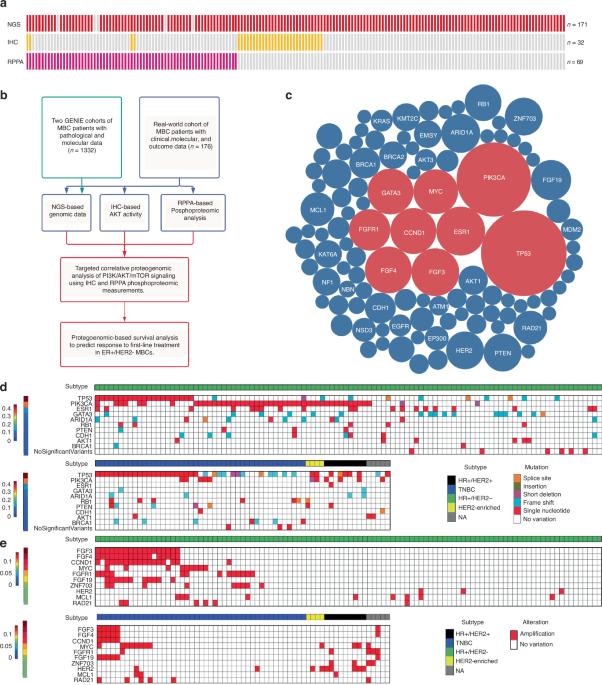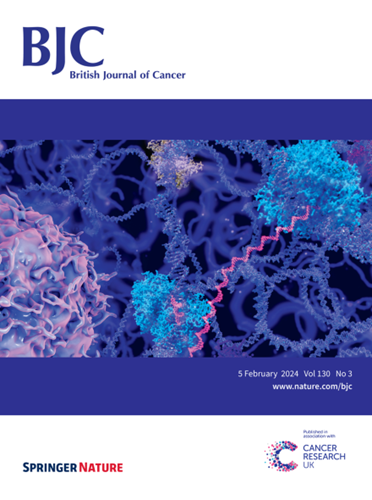真实世界转移性乳腺癌队列中 AKT-mTOR 信号轴的功能性激活。
IF 6.4
1区 医学
Q1 ONCOLOGY
引用次数: 0
摘要
背景:PIK3CA/AKT/mTOR轴的突变是转移性乳腺癌(MBC)中的常见事件。本研究旨在评估PIK3CA/AKT/mTOR的基因改变在多大程度上能预测MBCs中该信号轴的蛋白激活:分子图谱由通过 CLIA 认证的实验室从 171 例 MBC 患者的实际证据队列中生成。采用新一代测序技术测量了 PIK3CA 通路的基因改变。使用两种正交蛋白质组学方法量化了 AKT 和下游信号分子的激活水平。蛋白质活性与潜在的基因组图谱以及对CDK4/6抑制联合内分泌治疗(ET)的反应相关:结果:49.7%的病例发现了PIK3CA/AKT/PTEN通路的致癌改变。基因组图谱是蛋白质活性的不良预测因子(AUC:0.69),在76.9%的野生型肿瘤中,AKT磷酸化水平与突变病变相似。PI3K/AKT/mTOR下游靶点p70S6激酶(T389)的高磷酸化水平与CDK4/6抑制剂联合ET治疗患者较短的PFS相关(HR:4.18 95%CI:1.19-14.63);根据突变状态对患者进行分类时未发现这种关联:结论:基于磷蛋白的药物靶点和下游底物测量应与基因组信息一起采集,以识别由PI3K/AKT/mTOR信号驱动的MBC。本文章由计算机程序翻译,如有差异,请以英文原文为准。

Functional activation of the AKT-mTOR signalling axis in a real-world metastatic breast cancer cohort
Mutations of the PIK3CA/AKT/mTOR axis are common events in metastatic breast cancers (MBCs). This study was designed to evaluate the extent to which genetic alterations of the PIK3CA/AKT/mTOR can predict protein activation of this signalling axis in MBCs. Molecular profiles were generated by CLIA-certified laboratories from a real-world evidence cohort of 171 MBC patients. Genetic alterations of the PIK3CA pathway were measured using next-generation sequencing. Activation levels of AKT and downstream signalling molecules were quantified using two orthogonal proteomic methods. Protein activity was correlated with underlying genomic profiles and response to CDK4/6 inhibition in combination with endocrine treatment (ET). Oncogenic alterations of the PIK3CA/AKT/PTEN pathway were identified in 49.7% of cases. Genomic profiles emerged as poor predictors of protein activity (AUC:0.69), and AKT phosphorylation levels mimicked those of mutant lesions in 76.9% of wild-type tumours. High phosphorylation levels of the PI3K/AKT/mTOR downstream target p70S6 Kinase (T389) were associated with shorter PFS in patients treated with CDK4/6 inhibitors in combination with ET (HR:4.18 95%CI:1.19–14.63); this association was not seen when patients were classified by mutational status. Phosphoprotein-based measurements of drug targets and downstream substrates should be captured along with genomic information to identify MBCs driven by the PI3K/AKT/mTOR signalling.
求助全文
通过发布文献求助,成功后即可免费获取论文全文。
去求助
来源期刊

British Journal of Cancer
医学-肿瘤学
CiteScore
15.10
自引率
1.10%
发文量
383
审稿时长
6 months
期刊介绍:
The British Journal of Cancer is one of the most-cited general cancer journals, publishing significant advances in translational and clinical cancer research.It also publishes high-quality reviews and thought-provoking comment on all aspects of cancer prevention,diagnosis and treatment.
 求助内容:
求助内容: 应助结果提醒方式:
应助结果提醒方式:


